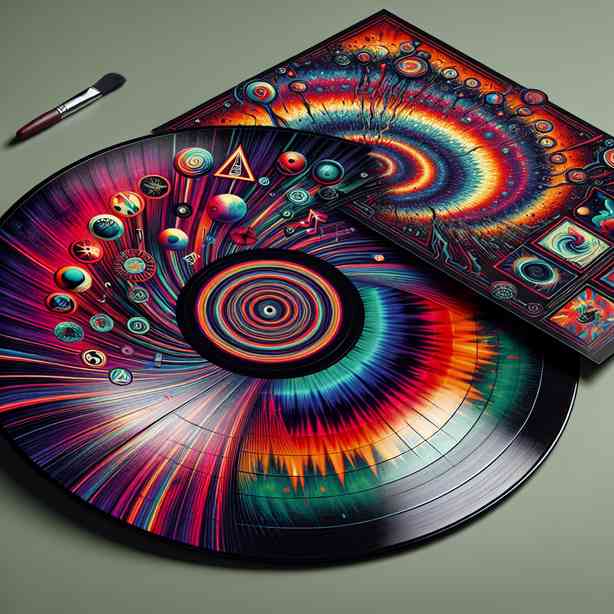
Album art has long been a crucial part of the music experience, serving not just as a visual accessory but as an integral component that shapes listener expectations. It encapsulates the artist’s vision and provides insight into the themes and emotions that the music might evoke. When we glance at an album cover, we often form instant impressions that can influence our perception of the music even before we press play. The right album art can entice listeners, setting the stage for an immersive auditory experience.
Take, for instance, the iconic cover of Pink Floyd’s “The Dark Side of the Moon.” The minimalist design featuring a prism and light spectrum is not merely a graphic design choice; it visually represents the album’s exploration of complex themes like time, mental health, and the nature of human experience. People looking at that cover might conjure a sense of depth and philosophical inquiry, priming them for a listening journey that reflects those very themes. The stark simplicity of the design contrasts with the intricate sounds within, creating an expectation of profound exploration.
On the other hand, some album covers play with contrasting imagery to create intrigue. For example, the cover of Nirvana’s “Nevermind” features a baby swimming towards a dollar bill. While it might seem whimsical at first glance, it sets the stage for the raw and rebellious music it contains. This duality within the cover art encapsulates the essence of the grunge movement and initiates a listener’s confrontation with societal expectations of success and innocence. The album art serves as both a visual entry point and a thematic guide.
There are also instances where album art can radically change our expectations. When Beyoncé released her self-titled album in 2013, the cover art was shockingly simple: just a close-up of her face. This straightforward portrayal captivated audiences and prepped them for a series of deeply personal and experimental songs that veered away from her earlier, more commercial sound. The simplicity of the art stripped away the glamor typically associated with pop albums, prompting listeners to engage with the raw emotions and narratives within. In doing so, the cover dramatically shifted expectations of both the artist and the genre as a whole.
Moreover, the use of photography in album art can elicit strong emotional responses, enhancing the listener’s connection to the music. The hauntingly beautiful cover of Fleetwood Mac’s “Rumours,” featuring a candid shot of Stevie Nicks and Lindsey Buckingham, draws listeners into a world of personal heartbreak and relational complexity. The visual representation resonates with the themes of love, betrayal, and longing that permeate the album, effectively preparing listeners for an emotional rollercoaster as they listen to the tracks unfold.
The cultural context surrounding an album cover can also significantly alter its impact. The cover for Kendrick Lamar’s “To Pimp a Butterfly” depicts a group of African American men standing in front of the White House with a child on a throne. This powerful imagery encapsulates the album’s commentary on race, identity, and systemic oppression. When listeners see this cover, they are immediately placed in a mindset of social activism and reflection, setting high expectations regarding the depth and significance of the messages within the tracks.
In an era of digital streaming, the visual component of music is often relegated to a smaller screen, yet its significance remains unaltered. The album art acts as a cultural artifact, reflecting the era and the artist’s vision. In recent years, artists like Billie Eilish have understood the importance of creating captivating visuals to complement their sound. The cover of her album “When We All Fall Asleep, Where Do We Go?” features her with unsettling imagery that mirrors her innovative musical style. Such visual elements draw in listeners and set the expectation for a listening experience that is as captivating as the cover art suggests.
Intriguingly, album art can also challenge societal norms and genre conventions. Artists like Childish Gambino have created covers that provoke thought and conversation, exemplified by the artwork for “Awaken, My Love!” featuring a vibrant, striking image that disrupts preconceived notions of R&B and soul music. The visuals establish a bold expectation for innovative sounds and themes that challenge genre boundaries, encouraging listeners to approach the music without preconceived limits.
As we explore how album art transcends mere decoration, we begin to realize that it significantly shapes listener expectations at various levels. From aesthetic appeal to cultural commentary, the process of selecting album art is often as intricate as the music creation itself. Artists and designers meticulously choose visuals that encapsulate the essence of their work, crafting an image that speaks to the core themes of the album while simultaneously engaging the audience in a way that promotes intrigue and connection.
In summary, album art is a pivotal element of the music experience that extends far beyond being visually appealing. It serves as a bridge between the artist’s intentions and the listener’s expectations, crafting a narrative before the first note is even played. Iconic covers challenge, provoke, and entice, inviting listeners into rich and often complex worlds. As the landscape of music continues to evolve, one thing remains clear: the significance of thoughtful album art will always hold a special place in the hearts and minds of music lovers everywhere. The journey through sound begins with that first glance, forever changing expectations and deepening our relationship with the music itself.


